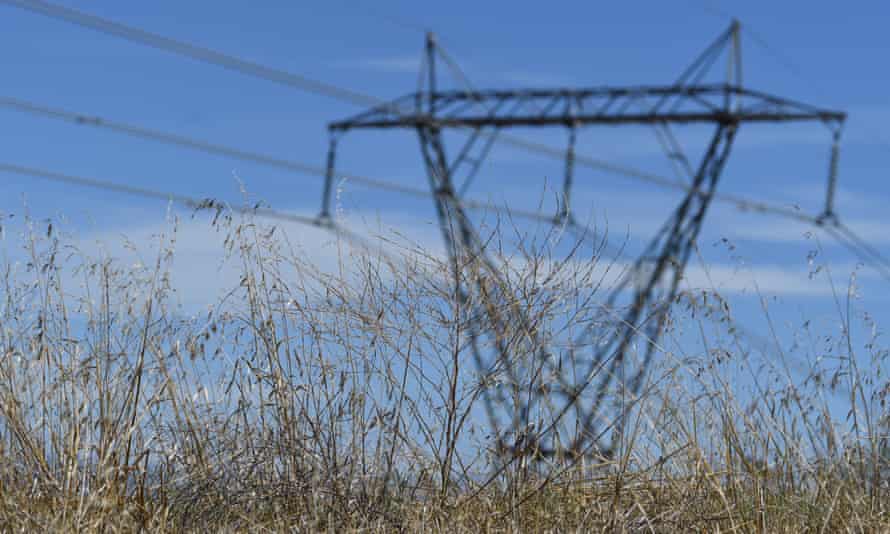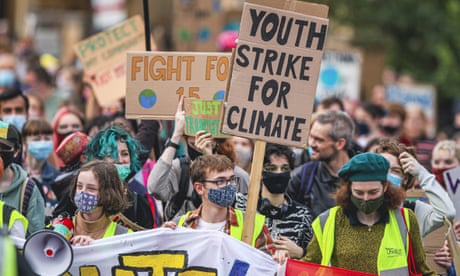Caring only about our emissions level in 29 years is a bit stupid. Any party worth its salt will stop putting things off and tell us what it’s doing right now

‘The end of the carbon price cost us precious time and didn’t deliver cheaper electricity.’ Photograph: Lukas Coch/AAP
Mon 27 Sep 2021
As the whispers grow of the government setting a 2050 target, data from the parliamentary library shows that ending the carbon price has not led to lower electricity prices.
So not only has removing the carbon price failed to deliver this aim, it also has ensured the task of achieving net zero emissions is much harder.
Too many people in politics and the media have bought into the idea that achieving net zero emissions by 2050 is all that is needed to avoid a climate crisis.
Back in February, a report by the Climate Targets Panel highlighted that we need to think less about net zero and more about our carbon budget.
Carbon emissions don’t disappear once the year passes, they keep adding up. So, the issue is not really net zero but how much in total we can emit to limit temperatures rising.
The targets panel estimated that to limit warming to 1.5C Australia has a carbon budget from 2021 of 3,521 Mt CO2, and to remain under 2C a budget of 6,161 Mt CO2.
Emit more than that and it doesn’t matter when we get to zero: we will have already emitted too much CO2 to prevent temperatures rising by those levels.
For context, our 2019 emissions were 551.6Mt CO2 – enough to use up our 2C budget in 11 years, and the 1.5C budget in six.
Caring only what level we will be in 29 years is a bit stupid.
Alas, the stupidity continues, given the prime minister claimed yesterday that “we’ve already reduced emissions in Australia by over 20% since 2005. We committed to Kyoto. We met that target and we beat that target. We’re going to meet and beat our Paris target as well.”
We have only reduced emissions by 20% if you include land use, which allows Australia to claim cuts because in 1990 (the Kyoto base year) and 2005 (the Paris base year) there was massive land clearing in NSW and Queensland.
If graph does not display click here
Exclude land use and we have only cut emissions by 2% since 2005.
This is also the government that removed the carbon price – done nationally to lower electricity prices and supposedly ensure households did not pay for the cost of emission reductions.
Instead, the Liberal National party introduced direct action, which used taxes to pay companies to reduce emissions.
Thus, households paid via taxes to reduce emissions and yet, as new data commissioned by the Greens from the parliamentary library shows, we haven’t even got lower electricity prices.
If graph does not display click here

Cop26 climate talks will not fulfil aims of Paris agreement, key players warn
Every state under the national energy market has had higher average electricity prices since July 2014 than existed when the carbon price was in force.
The Greens leader, Adam Bandt, argues that “after eight years of Coalition climate denial, pollution and power costs are now both higher than under the Greens/Labor/independents carbon price’' and that, by repealing the carbon price, “the Coalition has lifted electricity prices and let polluters off the hook”.
Yet this is not the worst of it.
Under the carbon price, emissions were falling steadily.
Had they kept falling at that rate, Australia would have emitted about 9% less CO2 in the past seven years and would have had about 330Mt CO2 extra in its carbon bank.
Click here if the graph does not display
The initial carbon price was meant to be just a start, but ending it made life so much harder because, if you don’t cut now, you have to cut much harder later to stay within your carbon budget.
Think of it like a car – would you prefer to slowly reduce speed 30m out to avoid hitting a pedestrian, or would you plan to slam on the brakes 3m away and hope for the best?
If we continue on our current path, all chance of remaining within our 1.5C carbon budget is gone, and to stay under the 2C budget we would need massive cuts after 2030.
Click here if the graph does not display
Those cuts would be harsh and crippling for the economy.
To stay within our 1.5C carbon budget, we need to get on a path to net zero by 2035 from now, not 2030.
To stay within our 2C budget we need to target 50% cuts by 2030.
Click here if the graph does not display
Net zero by 2050 is not enough – all it does is put things off until it is too late, under the guise of looking like action.
The end of the carbon price cost us precious time and didn’t deliver cheaper electricity.
Any party that wants to be taken seriously on the climate crisis needs to say what they will do not by 2050, but by 2025, 2030 and 2035.

Greg Jericho writes on economics for Guardian Australia
No comments:
Post a Comment